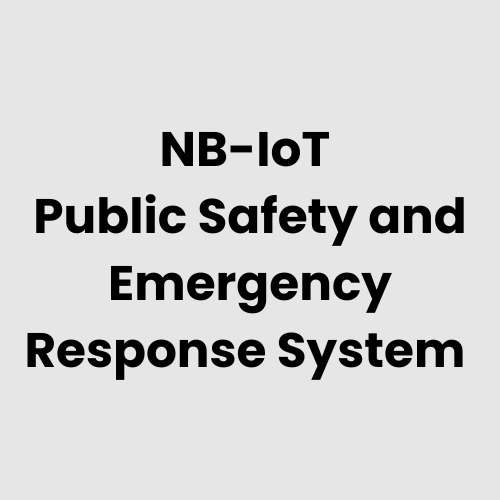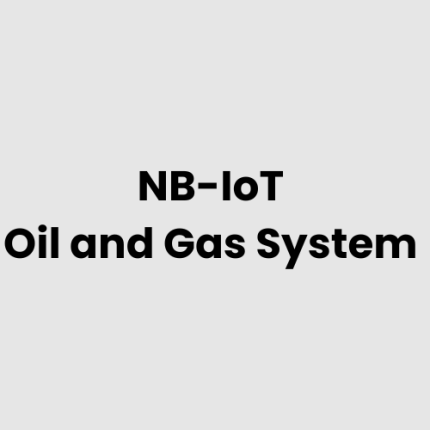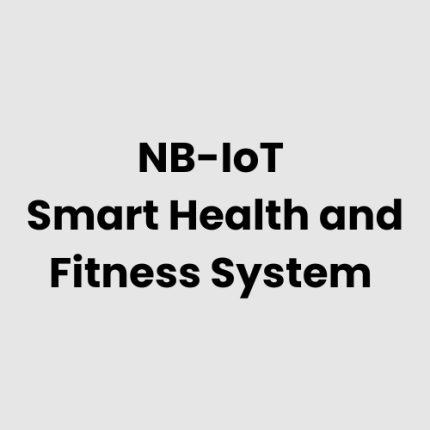Description
NB-IoT Enabled Public Safety and Emergency Response System
Technical Architecture
The NB-IoT Enabled Public Safety and Emergency Response System by GAO Tek is designed to enhance communication and operational efficiency in public safety and emergency response environments. This system combines advanced IoT sensors, NB-IoT connectivity, edge computing, and cloud integration to ensure that emergency personnel and first responders are equipped with real-time data to make informed decisions during critical situations.
The system is divided into the following layers:
- Sensor Layer:
- Environmental Sensors: Includes smoke, gas, and fire detection sensors placed in critical areas to monitor environmental hazards.
- Wearable Devices: Smart devices for personnel safety, including vital signs monitors (heart rate, temperature, etc.) and location tracking.
- CCTV Cameras and Drones: Provide live visual feeds, which are critical for situational awareness and remote monitoring of emergencies.
- Emergency Alert Sensors: Devices to detect and trigger alarms in case of emergencies like fires, chemical spills, or gas leaks.
- Connectivity Layer:
- NB-IoT Gateways: Devices that collect sensor data from the field and transmit it via low-power wide-area networks (LPWAN), providing a stable and secure connection in remote or urban settings.
- Edge Computing Layer:
- Edge devices process incoming data from sensors locally to ensure rapid action when required, reducing latency and dependency on centralized cloud processing for time-sensitive decisions.
- Cloud Data Management Layer:
- Data from all sensors and edge devices is aggregated, analyzed, and stored in the cloud, ensuring data availability, long-term storage, and the ability to scale the system as needed.
- Analytics and Response Layer:
- Provides actionable insights through real-time dashboards for emergency response teams, and integrates with emergency management systems to streamline decision-making.
List of Hardware
- Environmental and Hazard Detection Sensors:
- Smoke, gas, and fire detection sensors for real-time monitoring of hazards in high-risk areas.
- Flood sensors, temperature sensors, and humidity sensors to detect environmental changes that could indicate an emergency.
- Wearable Devices for First Responders:
- Smart watches or wristbands with vital signs monitoring (heart rate, body temperature) and GPS tracking for personnel safety and coordination.
- CCTV Cameras and Drones:
- High-definition cameras and unmanned aerial vehicles (UAVs) for real-time surveillance, offering situational awareness and aiding in large-scale emergency management.
- NB-IoT Gateways:
- These gateways act as communication hubs, collecting data from various sensors and devices, and transmitting it to a central server or cloud application over the NB-IoT network.
- Edge Computing Devices:
- Devices that process critical data locally to ensure immediate actions can be taken in emergency situations, reducing dependency on cloud latency.
- Emergency Alert Systems:
- Sirens, alarms, and alert systems that trigger warnings during critical events like fires or gas leaks, enabling rapid public and responder awareness.
- Centralized Control Systems:
- Operations centers that aggregate real-time data from all system components and provide operational insights and responses based on sensor data.
Physical Placement Considerations
- Environmental and Hazard Detection Sensors:
- These sensors are placed in high-risk areas such as fire-prone zones, industrial plants, or underground facilities. Sensors are often mounted on walls, ceilings, and poles where hazards are likely to occur.
- Wearable Devices for First Responders:
- Worn by emergency personnel during operations in hazardous environments. These devices monitor the worker’s vital signs, providing real-time health status updates to control centers.
- CCTV Cameras and Drones:
- CCTV cameras should be placed in strategic locations to cover critical zones such as entrances, exits, or areas that need constant monitoring. Drones are deployed in large-scale emergency situations for aerial surveillance.
- NB-IoT Gateways:
- These should be placed strategically throughout the service area to ensure seamless communication. Ideally located in areas with minimal interference, these gateways should be weatherproof and rugged for harsh environments.
- Edge Computing Devices:
- Positioned near the data source (e.g., within local control stations or mobile units) to enable quick processing of emergency-related data.
- Centralized Control Systems:
- Housed in emergency response centers, these systems receive data from all sensors and devices, allowing operators to make quick decisions.
Hardware Architecture
- Sensor Layer:
- The sensor layer consists of a range of environmental, health, and safety monitoring devices deployed across various public safety zones. These devices provide the real-time data required to assess risks and trigger alerts.
- Connectivity Layer:
- NB-IoT Gateways act as the communication hub, securely transmitting sensor data over wide-area networks. These devices ensure connectivity even in remote areas or urban environments with high traffic.
- Edge Computing Layer:
- Edge computing devices handle critical data processing near the source, allowing immediate action to be taken based on real-time data. This layer significantly reduces latency, especially for life-saving operations.
- Data Aggregation Layer:
- Data from all the sensors and edge devices are aggregated in the cloud or on a local server for centralized storage, providing an overarching view of the entire emergency response network.
- Analytics and Response Layer:
- This layer processes the aggregated data to provide actionable insights, predictive analytics, and emergency responses via easy-to-read dashboards.
- Security Layer:
- To protect sensitive data, the system uses advanced encryption methods for both data transmission and storage. Secure authentication and access controls ensure that only authorized personnel can access the data.
Deployment Considerations
- Network Availability and Coverage:
- Ensuring NB-IoT coverage is essential, especially for remote or rural areas. The system should be capable of functioning in urban environments with high traffic as well as in remote areas with limited network infrastructure.
- Energy Efficiency:
- Many of the devices should be energy-efficient to enable long-term operation, particularly in areas where power sources are limited or unreliable.
- Real-Time Data Processing:
- Edge computing devices should be deployed to handle time-sensitive data processing locally, ensuring quick decision-making during emergencies.
- Scalability and Flexibility:
- The system must be easily scalable to accommodate new devices, sensors, or regions. This flexibility is critical as the needs of public safety and emergency response teams evolve.
- Harsh Environment Considerations:
- Devices, especially sensors and gateways, should be ruggedized to withstand adverse environmental conditions such as extreme weather, dust, and temperature fluctuations.
- Security and Compliance:
- Public safety systems must adhere to strict security protocols and comply with local and international standards regarding data protection and privacy.
- Integration with Existing Systems:
- The system should be designed to integrate with existing public safety infrastructures and management systems to ensure smooth operations and effective use of available resources.
List of Relevant Industry Standards and Regulations
- ISO 9001 – Quality management systems
- ISO/IEC 27001 – Information security management
- NFPA 72 – National Fire Alarm and Signaling Code
- NIST SP 800-53 – Security and privacy controls for federal information systems
- IEC 61508 – Functional safety
- EN 50131 – Intruder alarm systems
- ISO/IEC 27018 – Code of practice for protection of personal data in the cloud
Local Server Version
The NB-IoT Enabled Public Safety and Emergency Response System can also be deployed with a local server, offering several key advantages:
- Real-Time Processing:
- Local server systems provide real-time data processing without depending on internet connectivity, ensuring immediate access to critical data during emergencies.
- Data Security:
- Storing data locally increases control over sensitive emergency response information, providing an additional layer of protection.
- Improved Reliability:
- In regions with unreliable or intermittent internet connectivity, local servers ensure continuous operation without interruptions.
- Customization:
- A local server provides the flexibility to tailor the system to specific organizational requirements, offering customization for workflows, reporting, and data storage.
Cloud Integration and Data Management
- Remote Monitoring and Response:
- The system can integrate with cloud platforms for remote monitoring of public safety networks. Emergency response teams can access live data and make decisions from anywhere.
- Advanced Analytics:
- Cloud integration enables the use
of advanced analytics and machine learning tools to assess trends, predict emergencies, and generate actionable insights to optimize responses.
- Data Storage and Scalability:
- Cloud-based storage allows for scalable data management, ensuring that large volumes of sensor data are stored securely while maintaining quick access for future analysis.
- Disaster Recovery:
- Cloud integration supports disaster recovery protocols, ensuring that critical data is not lost and can be quickly restored in case of system failures.
- Interoperability:
- The cloud environment allows the system to integrate seamlessly with other public safety platforms, ensuring that data from multiple sources can be consolidated and analyzed in a single interface.
- Security and Compliance:
- Cloud data management complies with industry standards for data security, ensuring that all information is encrypted and protected from unauthorized access.
GAO Case Studies of NB-IoT Enabled Public Safety and Emergency Response System
USA Case Studies
- New York City, New York
In New York City, NB-IoT is used to monitor emergency response vehicles in real time. By integrating sensors into vehicles, GAO Tek’s solution enables the city’s emergency teams to track response times, route optimization, and vehicle health, significantly improving response efficiency and public safety. Learn more about smart city solutions. - Los Angeles, California
Los Angeles deploys NB-IoT to monitor public safety systems such as surveillance cameras and emergency alarms. GAO Tek’s technology ensures that emergency systems are always operational and able to alert authorities in real time, enhancing rapid response to incidents. Find out more on urban safety. - Chicago, Illinois
In Chicago, public safety teams use NB-IoT to track the status of critical emergency equipment, such as fire hydrants and medical supplies. GAO Tek’s system allows quick access to data on equipment readiness, improving preparedness for emergency situations. Explore more on public safety monitoring. - Miami, Florida
NB-IoT technology is used in Miami to monitor weather-related emergency systems, including flood sensors and stormwater systems. GAO Tek’s solutions help authorities monitor real-time conditions and respond swiftly to mitigate damage caused by flooding. Learn more about flood management. - Dallas, Texas
In Dallas, NB-IoT is employed in public safety systems that track public health and emergency incidents, such as hospital statuses and fire department readiness. GAO Tek’s platform provides real-time data that helps local authorities improve response times and resources allocation during emergencies. Explore emergency response management. - Seattle, Washington
Seattle uses NB-IoT to monitor emergency evacuation routes and public safety infrastructure in areas prone to wildfires. GAO Tek’s system ensures that evacuation plans are up-to-date and that fire teams are alerted in real time, reducing response time and risk. Learn about fire safety IoT. - San Francisco, California
In San Francisco, NB-IoT technology supports the city’s public safety system by integrating smart sensors to monitor emergency lighting, flood-prone areas, and building evacuation routes. GAO Tek’s system enables proactive responses to potential hazards, enhancing overall public safety. Discover more about IoT in disaster management. - Phoenix, Arizona
In Phoenix, emergency response teams use NB-IoT solutions to track and monitor the city’s hazardous waste sites. GAO Tek’s platform provides critical environmental data in real-time, helping authorities ensure public health and safety during emergencies. Learn more about hazardous material management. - Boston, Massachusetts
Boston’s public safety teams use NB-IoT to monitor environmental conditions, such as air quality, during emergency situations. GAO Tek’s technology provides real-time updates, allowing authorities to act quickly and minimize harm to public health during environmental crises. Find out more on environmental monitoring. - Atlanta, Georgia
In Atlanta, NB-IoT sensors are deployed to monitor the readiness of emergency shelters and response centers. GAO Tek’s system helps manage resources in real time, ensuring that shelters are equipped and operational during times of disaster. Learn more about disaster relief systems. - Washington, D.C.
Washington D.C. uses NB-IoT to enhance communication systems for emergency services. GAO Tek’s IoT solutions ensure reliable, real-time updates for emergency responders, improving coordination during critical situations, such as terrorist threats or large-scale evacuations. Explore emergency communications. - Houston, Texas
Houston integrates NB-IoT to manage emergency medical systems, including ambulance locations and hospital bed availability. GAO Tek’s platform allows authorities to quickly assess available resources, ensuring the rapid deployment of medical teams during emergencies. Learn more about emergency healthcare. - Philadelphia, Pennsylvania
In Philadelphia, NB-IoT technology is used to monitor emergency alert systems across the city. GAO Tek’s system ensures that alerts are timely and precise, improving the city’s ability to respond to natural disasters and other public safety threats. Discover more about emergency alert systems. - Denver, Colorado
NB-IoT solutions are employed in Denver to monitor air quality during emergency events, especially in wildfire-prone areas. GAO Tek’s technology provides real-time environmental data, helping emergency response teams take appropriate actions to protect public health. Explore more on wildfire monitoring. - Minneapolis, Minnesota
Minneapolis uses NB-IoT to integrate sensors into its emergency lighting systems, monitoring power failures and ensuring critical infrastructure remains operational during blackouts. GAO Tek’s technology enables quick troubleshooting and the efficient restoration of services. Learn about critical infrastructure monitoring.
Canada Case Studies
- Toronto, Ontario
In Toronto, NB-IoT technology is used for real-time monitoring of emergency services such as police and fire department availability. GAO Tek’s solution helps dispatchers efficiently allocate resources, ensuring rapid responses to incidents. Learn about Toronto emergency services. - Vancouver, British Columbia
Vancouver utilizes NB-IoT to monitor its public safety infrastructure, such as emergency evacuation routes and air quality. GAO Tek’s solution provides authorities with instant updates, ensuring a quick and coordinated response to environmental hazards or disasters. Discover more about Vancouver emergency response.
Navigation Menu for NB-IoT
Navigation Menu for IoT
- LORAWAN
- Wi-Fi HaLow
- Z-WAVE
- BLE & RFID
- NB-IOT
- CELLULAR IOT
- GPS IOT
- IOT SENSORS
- EDGE COMPUTING
- IOT SYSTEMS
Our products are in stock and can be shipped anywhere in the continental U.S. or Canada from our local warehouse. For any further information, please fill out this form or email us.
We are actively looking for partners who are like us located in the U.S. and Canada. For more information on partnering with GAO, please visit Partner with GAO Tek Inc. It lists various ways to partner with GAO, such as OEM Partnerships, Technology Integration, Distribution and Reselling Opportunities, Presenting at the Leading Event Tek Summit, Joint R&D Projects, Training and Consulting Services, Industry-Specific Collaborations, Research and Academic Partnerships.



